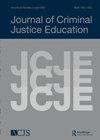拉丁/o/x犯罪学与司法:教育学、课程、表现与反思。特刊简介
IF 0.9
Q3 CRIMINOLOGY & PENOLOGY
引用次数: 0
摘要
美国有近2000所公立高等教育机构,为1300多万本科生(其中近300万是拉丁裔)提供了现代经济中经济安全的关键——高等教育学位。作为获得公立中学后教育的主要和最实惠的途径,国家的民主、经济和劳动力从根本上建立在受过教育的公民基础上。同样显而易见的是,在过去二十年中,美国犯罪学和刑事司法(CCJ)项目、学生入学人数以及教职员工的雇佣人数都急剧增加(Cao,2020;Stringer&Murphy,2020)。有人认为,CCJ的这种增长反映了一种历史性的社会、文化和政策转变,从社会控制转向公众对执法和社区关系的审查,尤其是对资源不足和边缘化的少数族裔社区(Russell Brown,2021;斯特林格和墨菲,2020)。从本质上讲,可以说,CCJ在近代史上的广泛发展从根本上是由公众和社会对刑事法律制度的系统性变革的需求驱动的,而刑事法律制度在历史上一直在再现种族/族裔差异和不平等。这一点很重要,因为每年有超过60000个CCJ学位授予,这表明CCJ专业比许多其他社会科学学科都要多(斯隆,2019;斯隆和布赫沃特,2017;斯特林格和墨菲,2020)。同样的模式也反映在研究生学位中(Cooper,Updegrove,&Bouffard,2019;Stringer&Murphy,2020)。尽管如此,在刑事法律体系的各个方面,拉丁裔/非裔个人的比例仍然过高,但拉丁裔学生的比例仍然偏低,处于边缘地位。在Vélez和Peguero(2023)最近的一篇文章中,美国拉丁裔人口本文章由计算机程序翻译,如有差异,请以英文原文为准。
Latina/o/x Criminology and Justice: Pedagogy, Curriculum, Representation, and Reflections. An Introduction to the Special Issue
The United States (US) has almost two-thousand public postsecondary institutions, which provide more than thirteen million undergraduates (nearly three million of them are Latina/o/x) with what is perhaps the key to economic security in the modern economy—a degree in higher education. As the primary and most affordable access points to public postsecondary education the nation’s democracy, economy, and labor force are fundamentally founded on an educated citizenry. It is also clear that the number of Criminology and Criminal Justice (CCJ) programs, student enrollment, and faculty and staff hires have dramatically increased in the past two decades in the US (Cao, 2020; Stringer & Murphy, 2020). It is argued that this growth in CCJ reflect a historical social, cultural, and policy shift from social control to public-scrutiny about law enforcement and community relationships, especially for underresourced and marginalized minority communities (Russell-Brown, 2021; Stringer & Murphy, 2020). In essence, it can be argued that the expansive growth of CCJ in recent history is fundamentally being driven by the public and social demand for a systemic change of a criminal legal system that has historically and persistently reproduced racial/ ethnic disparities and inequality. This is important to consider while over 60,000 CCJ degrees are awarded annually and establishes that CCJ majors is much greater than many other social science disciplines (Sloan, 2019; Sloan & Buchwalter, 2017; Stringer & Murphy, 2020). This same pattern is also reflected in post-graduate degrees as well (Cooper, Updegrove, & Bouffard, 2019; Stringer & Murphy, 2020). Nevertheless, Latina/o/x individuals remain overrepresented in all aspects of the criminal legal system, yet Latina/o/x students remain underrepresented and marginalized. In a recent article by Vélez and Peguero (2023), the US Latina/o/x population
求助全文
通过发布文献求助,成功后即可免费获取论文全文。
去求助
来源期刊

JOURNAL OF CRIMINAL JUSTICE EDUCATION
CRIMINOLOGY & PENOLOGY-
CiteScore
1.90
自引率
36.40%
发文量
52
期刊介绍:
The Journal of Criminal Justice Education (JCJE) is an official publication of the Academy of Criminal Justice Sciences (ACJS). JCJE provides a forum for the examination, discussion and debate of a broad range of issues concerning post-secondary education in criminal justice, criminology and related areas. The aim of JCJE is to enhance the quality of higher education in criminal justice and criminology. JCJE is an education-oriented journal for those undertaking educational and academic endeavors in the fields of criminal justice and criminology. Quality articles that address specific educational or academic issues in these areas are encouraged and will be considered for publication.
 求助内容:
求助内容: 应助结果提醒方式:
应助结果提醒方式:


